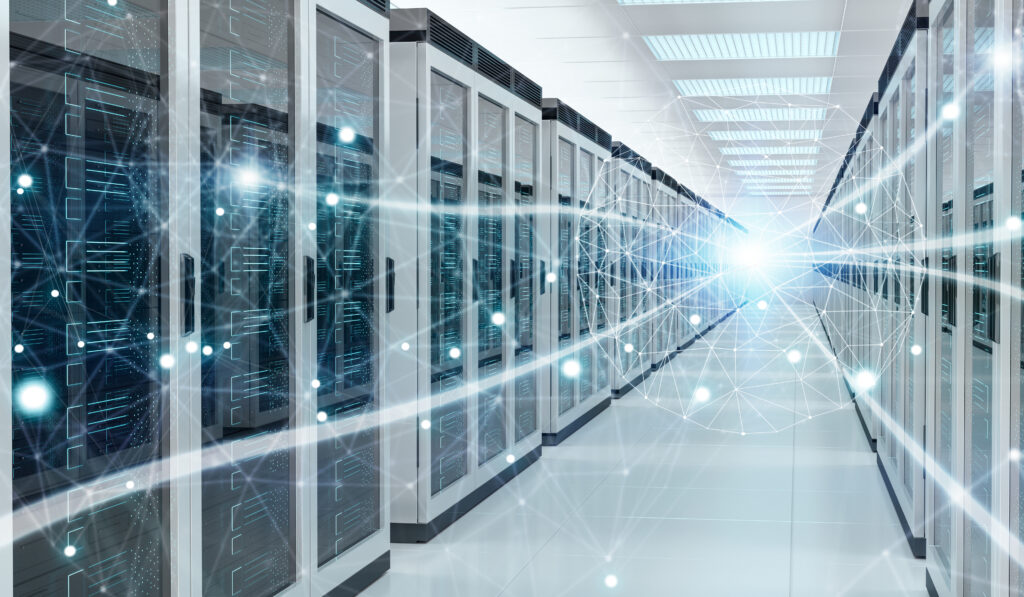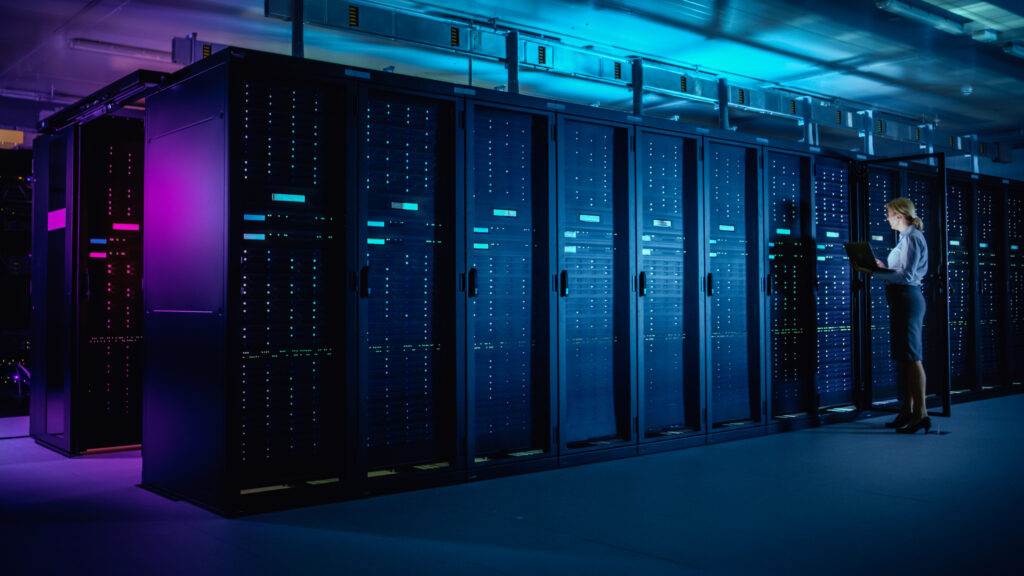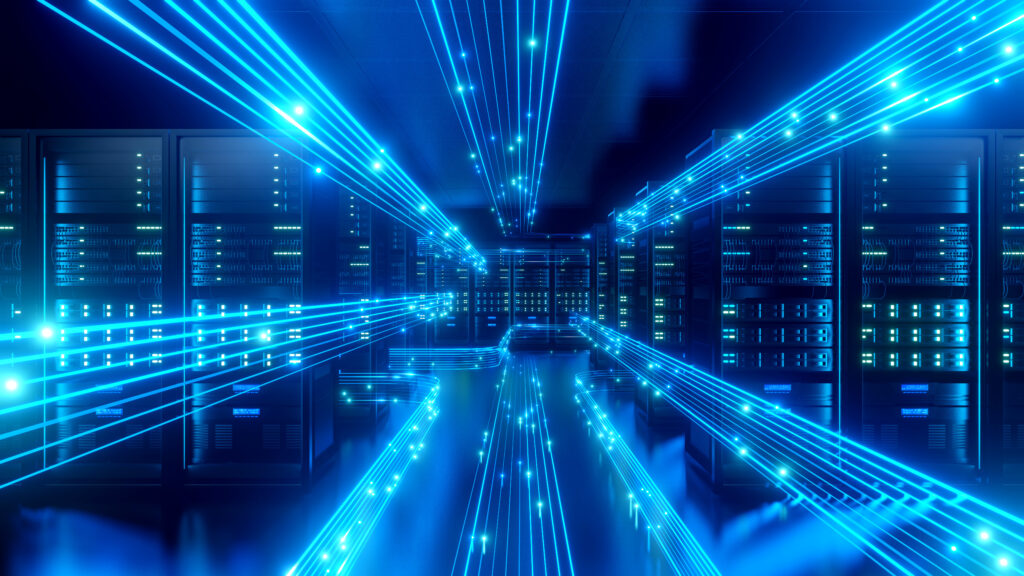We live in an era where data has become a cornerstone of our everyday lives. Amid the rapid pace of digital transformation, the world is expected to produce 180 zettabytes of data by 2025. Such enormous quantities of information necessitate a robust network infrastructure capable of processing, storing, and distributing this data – and this is where Data Centers come into play.
In this article, we will delve into what Data Centers are, their different types, and the critical role they play in our everyday lives. We will also explore how data center providers, like EdgeUno, are leveraging the latest technologies to meet the demands of our ever-growing digital world.
 Credits IStock
Credits IStock
What are Data Centers?
Data Centers are specialized facilities designed to house and protect computer systems, data storage systems, and associated components such as telecommunications and network devices. They’re comprised of servers, storage devices, cables, and a vast array of networking equipment – all working in harmony to ensure the smooth transmission and processing of data.
These complex facilities are not only about hardware. They are meticulously managed environments that are carefully controlled to maintain optimal temperature, humidity, and security levels. Furthermore, efficient data centers have backup power supplies, redundant data communications connections, and various security systems to ensure business continuity and data protection.
Why are data centers important for businesses and consumers?
Data Centers play an increasingly critical role in the operational framework of both businesses and consumers. For businesses, they serve as the hub for their IT operations and equipment, where they store, process, and disseminate data.
They are essential to guarantee business continuity because they offer high availability, reliability, and security of data. Their resilience against power outages, failure of network services, and other disasters means businesses can keep their digital operations running smoothly all day long.
On the other hand, consumers might not realize how heavily they rely on data centers. Whenever they stream their favorite TV show, use a social media app, participate in online gaming, or even send an email, they’re interacting with a data center. The performance, speed, and reliability of most digital services we enjoy are contingent on the efficient operation of data centers.
4 Types of Data Centers
 Credits IStock
Credits IStock
With the evolution of technology and varying data needs, the concept of a ‘data center’ is no longer confined to a room filled with servers. Instead, the term now encapsulates a variety of architectures, each designed to meet specific business needs and address the challenges associated with data storage, processing, and distribution.
Different types of data centers have emerged over time, including:
- Edge Data Centers
- Hyperscale Data Centers
- Colocation Data Centers
- Modular Data Centers
Each type has its own characteristics, advantages, and disadvantages, which we’ll explore further.
The selection of a specific type of data center is often driven by several factors, such as:
- Nature of the business
- Volume and type of data being handled
- Business applications being used
- Regulatory requirements
- Available resources
For instance, a multinational company offering a popular streaming service may rely on a hyperscale data center due to its massive data and computational requirements. At the same time, a local business may benefit from an edge data center to deliver data and services quickly to local users.
Understanding the different types of data centers is a vital step in determining the most appropriate data center infrastructures for a business or service. This diversity among data center types allows for an optimized, tailored approach to data management, ensuring that data can be handled effectively and efficiently across different scenarios.
Let’s explore these four types of data centers in more detail.
Edge Data Centers
Edge data centers are small, localized facilities that are strategically located closer to the users or data sources. They are designed to reduce latency in data delivery, providing faster response times and a better user experience, particularly for real-time and latency-critical applications.
The primary advantage of edge data centers is their proximity to end-users, which greatly reduces the distance that data must travel, thereby speeding up data processing. As a result, businesses can offer real-time services, such as IoT applications, video streaming, gaming, and virtual or augmented reality applications.
According to a report, the edge data center market size was valued at USD 9.36 billion in 2022 and in the period from 2023-2030, it’s expected to grow at a compound annual growth rate (CAGR) of 18.4%. This growth is attributed to the increasing adoption of IoT across industries and the need for lower latency.
Hyperscale Data Centers
As the name suggests, hyperscale data centers are real enterprise data centers. They are vast facilities, often operated by hyperscale customers, usually tech giants like Amazon, Microsoft, and Google. They can contain thousands to millions of servers and other IT resources, making them ideal for massive workloads that require high-speed connectivity and extensive processing power.
Hyperscale data centers are designed for horizontal scalability to accommodate increased demand. This scalability makes them highly flexible and efficient, as resources can be added or removed dynamically based on the workload.
The global market of hyperscale data centers is expected to grow at a CAGR of 16.7%, from $35.72 billion in year 2022 to $41.69 billion in year 2023. This demonstrates the rapidly growing demand for high-capacity data centers capable of supporting extensive computational workloads, such as big data analysis, cloud services, and machine learning algorithms.
Colocation Data Centers
In a colocation Data Center model, businesses rent space in a colocation facility owned by a third party to house their servers and other hardware. These on-premises data centers provide the building, cooling, power, bandwidth, and physical security while the customer provides and manages the servers and storage.
A colocation Data Center allows businesses to avoid the significant capital expenditures and operational complexities involved in building and maintaining their own data center facilities. They provide a high level of flexibility and scalability, allowing businesses to increase their production capacity as needed.
Modular Data Centers
Modular Data Centers, also known as containerized or portable data centers, are self-contained, portable data centers built into a shipping container. The purpose of modular data center design is to be flexible, scalable, and quickly deployable, which makes them ideal for remote locations, temporary deployments, or disaster recovery scenarios.
Modular Data Centers come in various sizes and capacities, depending on the specific needs of a business. They offer many of the same benefits as traditional data centers, including security, cooling systems, and uninterruptible power supplies, but in a compact and mobile format.
Benefits of EdgeUno’s Data Center Solutions
Edge Data Centers have garnered considerable interest in recent years due to the array of benefits they offer. They are poised to remain a key area of focus in the foreseeable future.
The transition of Data Centers to the edge yields four primary benefits:
- They enhance security by restricting the amount of stored data, mitigating broad network vulnerabilities, and curtailing the transmission of sensitive data.
- They offer lower latency, leading to significantly faster response times. By locating computation and storage closer to end users, the chances of encountering a transmission line with subpar data flow are reduced. For example, an user in Colombia will receive data from a data center Colombia-based facility, which significantly reduces response time.
- Edge data centers, by processing data locally, lessen the traffic routed to and from central servers. Consequently, more bandwidth becomes available across the user’s wider network, boosting the performance of the entire network.
- Finally, this type of data center services decreases routing and data transmission costs by reducing the traffic directed to and from central servers, a crucial factor for a high-bandwidth application performance. Specifically, by bringing storage and computing closer to the point of use, edge data centers reduce the need for costly interconnection hubs and circuits that connect to regional or cloud data centers, whether it’s private clouds or public cloud providers.
Innovative Data Center Technologies
 Credits IStock
Credits IStock
Data Center technologies have continually evolved to meet the changing demands of the digital world. The introduction of new technologies is aimed at improving efficiency, capacity, reliability, security, and environmental sustainability.
Below, we’ll delve into some of the key technologies currently transforming the data center landscape.
Virtualization
Virtualization has become an essential technology for many modern data centers. It involves the creation of a virtual version of an operating system, a server, a storage device, or network resources. Virtualization allows for greater flexibility, scalability, and efficiency, as it enables multiple virtual machines, each running its own operating system and applications, to run on a single physical server.
Software-defined networking (SDN)
SDN is a technology that decouples the network control and forwarding functions, enabling the data center network to be programmatically controlled and making network configuration more straightforward and efficient. SDN allows data centers to scale and adapt quickly to changes in business requirements.
Hyperconverged infrastructure (HCI)
HCI integrates computing, storage, and networking into a single system. This approach simplifies data center management and improves scalability. With HCI, data centers can easily add more capacity, as physical infrastructure and other data center resources are managed centrally, reducing the time and effort required for system administration.
AI and machine learning
Artificial intelligence (AI) and machine learning technologies are increasingly being used in data centers for predictive analysis and automation. These technologies can predict potential system failures, optimize energy use, and automate routine tasks, leading to improved reliability, efficiency, and cost savings.
Green technologies
With growing concerns about the environmental impact of data centers, green technologies are becoming more prevalent. These include energy-efficient servers, advanced data center cooling techniques, renewable energy sources, and intelligent power management systems, reducing carbon data center footprint, increasing environmental controls, and lowering energy costs.
Summary
As our digital reliance grows, so does the need for robust and efficient data management. Data centers, whether they’re edge, hyperscale, colocation, or modular, play a pivotal role in supporting our digital world. Each type of data center offers unique advantages and characteristics to cater to different needs, facilitating a diverse range of services from real-time applications to massive computational workloads.
In this modern era, where the digital economy continues to expand and technology is ever-evolving, data centers stand as the backbone of our interconnected world. They must not only meet the current needs but also anticipate future demands.
Innovations in data center technology, such as virtualization, software-defined networking, hyperconverged infrastructure, AI and machine learning, and green technologies, are paving the way for more efficient, reliable, and sustainable data centers. However, it’s also important to be aware of data center best practices in order to be able to get the most out of them.
Understanding these different types of data centers and the technologies that power them is integral for businesses to make informed decisions about their data management. In an era where data is often considered as valuable as currency, the right data center can be a powerful asset, driving business growth and digital transformation.